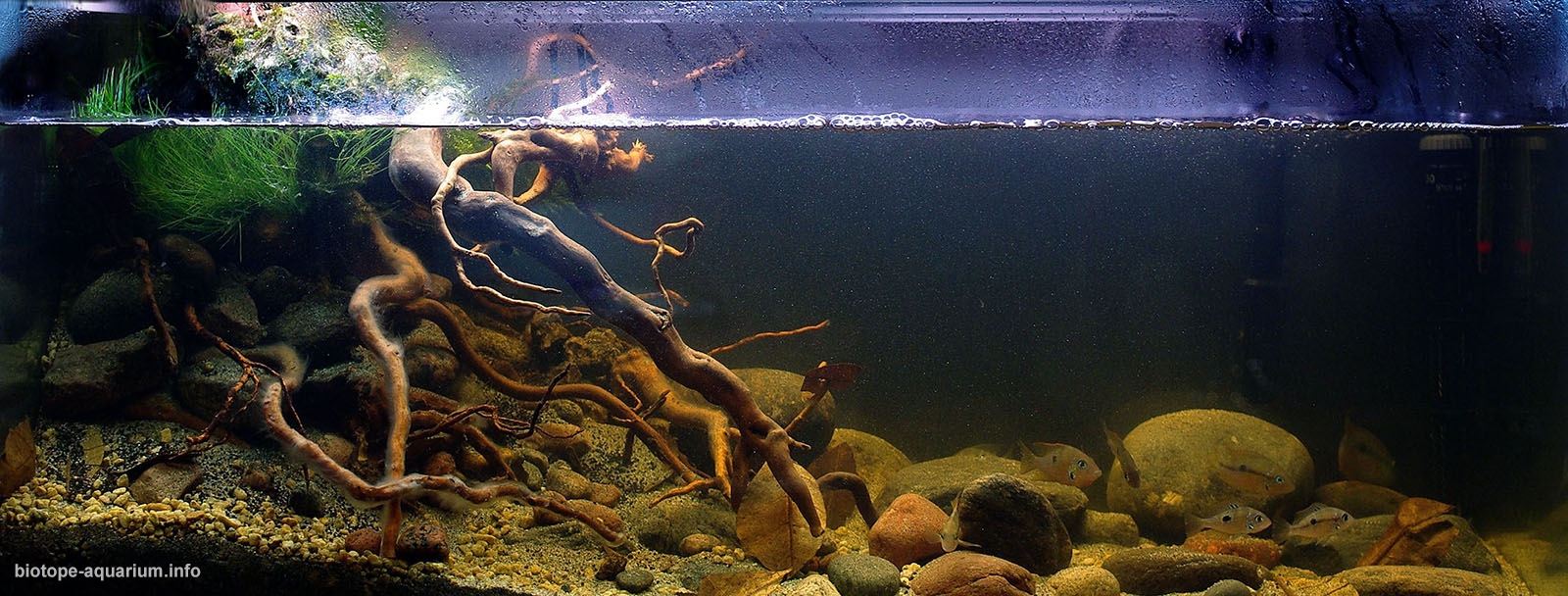Subbasin of Valle Nacional River, Oaxaca, Mexico
The 3rd place in the final of the Biotope Aquarium Design Contest 2014
![]() Mexico. Victor Manuel Ortiz Cruz
Mexico. Victor Manuel Ortiz Cruz

Volume: 180 L
List of fishes: Cichlasoma salvini, Thorichthys ellioti
List of plants: Eleocharis parvula, Fissidens fontanus, Fontinalis sp. “Willow”
Biotope description: Valle Nacional River feeds the Papaloapan River (the second largest in Mexico). The shown biotope is a bank stream on Atlantic slope. On its bottom there are grayish and slightly reddish oval rocks and sand sometimes covered with organic matter and leaves from trees and plants growing on banks. Submerged roots and branches provide food and shelter for the fry of Thorichthys ellioti, which often cohabit with Cichlasoma salvini and Poecilia sphenops. Near the banks there are more wood and leaves on the bottom, while rocks are predominant near the middle with no organic matter in the current. There is almost no aquatic plants here, only small patches of Eleocharis sp., Fontinalis and Fissidens mosses and riverine grass in some parts of the river.
Víctor’s comment about the contest: The contest is an excellent opportunity to show the beauty of natural waterbodies to the world, but also it allows us to point out the problems we may face, as in the case of most rivers and streams in Mexico, where there is a great biodiversity, but often it is threatened. That’s why the contest is a platform to promote environmental awareness among the aquarists. Personally I am very grateful to UNITEX, JBL and other sponsors that support and promote such events so that more people can participate. Thank you very much for the opportunity. I hope to participate next year. Greetings from Mexico.

It had been a pleasure meeting Victor and his team during the fair in St. Petersburg. Victor is such an active person, protecting endangered biotopes in Mexico and breeding fish at home. His Biotope Aquarium in the final looks 1:1 like an underwater picture of many Central American rivers. But in comparison to the Australian or African Biotope, his tank looks a bit empty.

4th place must be Biotope by Víctor, because the description is very well done, but missing a precise location on the Pacific slope, and the sub basin of Valley National River in Oaxaca is very large. There are some plants in this area (habitats), mainly Potamogeton (almost everywhere, even in strong current), as well as many Pontederia along the edges, and some more. Also Thorichthys ellioti is a Synonym of Thorichthys maculipinnis and can only be found on the Atlantic coast around Motzorongo, and Veracruz, in Mexico, and not in this habitat at all. The décor is nearly authentic for small creeks in that region, well done, but purely in plants and normally more coarse gravel.

This biotope representation does say central american river to me and I like the stones, mixed grade gravel and sand and also how you need to look carefully to spot the fish. This is how it would look to snorkel in that river. The terrestrial section and hair grass does less for me however and I would have preferred the tank to be deeper filled and the bank to rise up to the tank rim and out of site, instead of an air space which spoils the biotope illusion and exposes the filter pipework. The cichlids would be soon be acting out natural breeding behaviour in this biotope.

To put something special into a central american biotope tank is extremely difficult. Victor Manuel Ortiz Cruz made it. Having seen so many underwater footage of central american waters it’s obviously that Victor created a very good biotope aquarium. One can really imagine how that particular river would look like. Gravel and stones in different size and color, some wood and some mud covering everything. I think it’s the perfect environment for the cichlids in the tank. They find everything they need. Cover, places for breeding and the possibility to find food. The only two things that could have done better is the background on the right side of the aquarium and the cover of the filtration and heater. This open space partly breaks the general impression of the biotope. Creating a central american biotope tank is one of the hardest jobs you can choose but Viktor managed it very well and did something special. Great work!
Very harmonious and delicate aquarium. Particularly I really like the minimalist style, but i think that it might be best worked the part of rocks and the placement of plants. Nice work.

The entry is simple in design, but everything is biotope correct. I never saw C. salvini. These fishes also had to be put in a small group. Marginal zone does not look quite real. To the thick roots that appear from the steep bank, small roots also should be added.

A good arrangement of stones and wood, and also as decoration. Unfortunately too much equipment seen. Due to the quality of the decoration, fish feel well and are active, showing a healthy color. Congratulations for this set!

This is an impressive biotope aquarium. The round rocks and exposed tree roots along eroded river banks are just what I would expect to see if I went swimming in a river in Oaxaca. Víctor Manuel Ortiz made a great decision in creating a side slanted aquarium setup, it makes me feel like I am snorkeling along the river bank.

A very authentic biotope, with a great attempt to show an eroding bank with tree roots extending through the rockwork. It really looks as though the roots are holding up the bank. The transition from bank to deeper what is realistically represented. However, what it loses points for are the lack of some inhabitants that would surely be present in abundance – swordtails! There is not much attempt to conceal the filter parts either, they are very exposed in the open end of the tank. Although it may be true that the cichlids would hide under the roots as we can see, perhaps some overhanging vegetation or branches would have been helpful to let them feel more secure and show some interesting display behavior?
